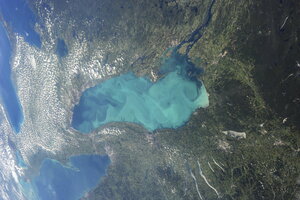Surprise: Earth had oxygen before Great Oxidation Event
Earth, it now unfolds, had substantial levels of oxygen about 600 million years before the so-called Great Oxidation Event.

Cyanobacteria bloom across Lake Ontario. The blue-green algae was responsible for the oxygenation of Earth and, according to a new paper in Nature, did so earlier than had been thought.
NASA/Reuters
Earth, it now unfolds, had substantial levels of oxygen about 600 million years earlier than thought.
Findings published this week in Nature suggest that Earth’s atmosphere was already somewhat oxygenated, if not quite oxygen rich, about 3 billion years ago. That revises previous timelines of our planet, which had put the first rumblings of oxygenation about 2.3 billion years ago, at the beginning of what is known as the Great Oxidation Event.
“Instead of a simple two-stage Early Earth model with anoxic atmosphere prior to 2.4 billion years ago and oxic conditions ever after, we had at least 600 million years long transition phase,” says Michael Bau, a geoscience professor at Jacobs University, in Germany, and an author on the paper.
The tale of Earth’s oxidization is often told like this: For the first 2 billion years of Earth’s existence, the mottled, volcano-pocked planet had little oxygen – about 0.00001 percent of current levels. But about 2.3 billion years ago, there was a dramatic change. In what was perhaps the happiest moment in Earth’s existence, photosynthesizing bacteria enjoying the sunlight began, in an unusually productive feat for sunbathers, to process it into oxygen.
It was, so far as we know, a moment unlike any other in the universe. While Mars, just 60 million years older than Earth, browned and reddened, Earth was furnished in greens and blues and, later, in all the brilliant colors that decorate its plants and animals and all the protists in between. The modern Earth owes about 85 percent of its oxygen to phytoplankton, beginning with the cyanobacteria – blue-green algae – that first quilted the planet those billions of years ago.
But a team of researchers has now posed the question: What if the oxygenation of Earth began not with a moment, but with a long transition phase?
The researchers assessed the distribution of two chromium isotopes, Chromium-53 and Chromium-52, in 3-billion-year-old sediment in South Africa’s Kwazulu-Natal Province. Since Chromium-53 becomes soluble when oxidized, and Chromium-52 is less affected, the relative distribution of the two furnishes a reliable measure of the extent to which the rocks have been exposed to oxygen.
The team found that the heavier isotope, Chromium-53 had been depleted in land soils, relative to Chromium-52. At the same time, Chromium-53 was enriched in the studied marine sediments, where it had ended up when it was washed out of the soil. This suggested that the isotope had been highly exposed to oxygen, becoming soluble enough to be moved from one sediment region to another.
Altogether, the researchers found that the 3-billion-year-old Earth had about 0.03 percent of the oxygen it does now, the authors said.
That oxygen level exceeds the amount of oxygen that can be produced in natural atmospheric reactions alone, the researchers said. So, it seems that bacteria were photosynthesizing at least 300 to 400 million years earlier than previous estimates plotting their contribution to Earth’s oxygen pool, they said.
Still, just who was doing what and where in this ancient ecosystem is still unknown, says Dr. Bau. One outstanding question is whether the oxygenation was a local or global phenomenon, he said, noting that it’s possible that bacteria were generating local oxygen oases around shelf seas or shallow lakes. To determine if the whole Earth was oxygenated, or just certain hotspots, more research is needed from different points around the world, he said.
The researchers also cautioned that this was a transition phase, not the “Great” event itself.
“The amount and rate of oxygen produced was not sufficient to permanently switch the system from ‘anoxic’ to ‘oxic,’” says Bau, in an e-mail. “This only happened during the ‘Great Oxidation Event’ about 2.3 – 2.4 billion years ago.”

